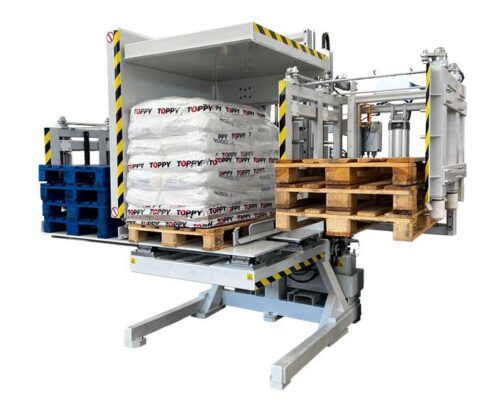Top Industries is the US leader for pallet inverters. For any kind of logistic operation, forklifts pallet inverter can be found in companies that need to exchange pallets.
The most elementary models were developed in the 1995. Subsequently, they can be compared with what we see today: advanced pallet inverters.

Forklifts pallet inverter have several uses such as:
- Raising
- Lowering’
- Stacking
- Organizing
- Carrying
- Pushing
- Pulling
- Putting materials on crates, pallets, etc.
Most warehouse forklifts pallet inverter can handle a load of one to five tons. A few larger forklifts can also lift up to 50 tons. Powered forklifts use a certain energy source and can be controlled by a walking operator.
In the USA, OSHA (Occupational Safety and Health Administration) regulates powered forklift use and directs that operators must be a minimum of 18 years old. Also, OSHA recommends completing 3 years of training for the forklift operators.
Choose a stand-alone machine instead of forklift pallet inverter, no regulations needed


Common types of forklift like forklift pallet inverter
1. Forklift pallet inverter
Whenever we visualize forklifts, then forklift pallet inverter come to our mind. These forklifts are used for most of the common functions of warehouses, including stocking orders, lifting equipment, moving and stacking materials, and much more.
Most warehouse forklifts are capable of handling up to an average 5,000 lbs. load, and some heavy-duty models are able to handle up to 20,000 lbs. payloads.
2. Pallet jack
Pallet jacks are also called:
- Pallet trucks
- Pallet pumps
They can be used as a tool to lift and move pallets. These are the simplest and also most basic forklift design featuring 2 forks typically 20¼” or 27” wide. Their basic function will be restricted to moving pallets inside a warehouse.
Typically, pallet jacks have got steering wheels in the front. Each fork has got either a single wheel or 2 bogie wheels. The pallet jack can lift pallets by inserting its forks below the pallet, and raising the forks with a hydraulic pump.
On average most pallet jacks can handle about 5,000 lbs. and some models can lift up to 8,000 lbs.


There are 3 common types of pallet jacks:
- Manual pallet jacks: These are hand-powered by the operator for lifting, lowering, and steering pallets from one location to another. Typically, manual pallet jacks are quite affordable as they feature a very simple design with very few moving parts and no engine. In most retail and warehousing operations, these are used.
- Powered pallet jacks: These are similar to the above pallet jacks in design. Nevertheless, there is an engine available for lifting and moving any heavier and stacked pallets. Few powered pallet jacks will feature an operator platform to stand upon while using.
- Rough terrain pallet jacks: These are used for uneven ground. They may feature heavy-duty frames with pneumatic tires for accommodating a wider range of surface types.

1. Walkie stacker
Walkie stackers can be another simple design having a mast to lift payloads to greater heights as compared to pallet jacks. Often, walkie stackers are known as a fusion of a forklift and pallet jack as they have got a simple design and can handle different loads. Walkie stackers are available in both manual and powered.
Typically, operators guide and maneuver them around the warehouse just by pulling the handle.
Most walkie stackers are meant for handling between the average of 2,000 and 3,000 lbs. Some models can lift up to 4,000 lbs. Based on make or model, lift heights may vary and may range between 6 and 14 feet.
2. Order pickers (stock pickers)
These are designed for handling one or two units by an operator rather than lifting a complete pallet. Operators who ride on a platform will raise and lower them to various levels of warehouse racks. Layer picker can help operators to pick up their orders within the warehouses.
Here, the operator will use the order picker to retrieve quickly and efficiently and then store items at different heights inside a warehouse.
These are very efficient and capable to maneuver in narrow aisles. Capabilities may vary as per make and model, however, most can handle between 300 lbs. and 3,000 lbs. A few can reach a height of a maximum of 32 feet.
3. Reach fork truck
Reach fork trucks offer operators the capability to reach into warehouse racks. They feature outrigger legs and forward-extending forks for enabling X and Y fork movement at heights up to 30 feet.
Fork reach trucks can lift a pallet high into the air, and extend the forks forward for placing a pallet onto a rack.
Typically fork reach trucks will handle loads between 2,000 lbs. and 5,000 lbs.
4. Rough terrain forklift
These forklifts are built for stability and high mobility on uneven soil, sand, rocks, and even soggy surfaces. Often these rough terrain forklifts are used in applications like docks, special events, outdoor yards, timber forestry, farms, and construction sites.
They will feature larger tires and engines to obtain more lifting capacity and also a reinforced cage cab for protecting the operator.
5. Industrial forklift pallet inverter (large capacity forklift)
These forklifts can lift much heavier loads as compared to other warehouse telehandlers and forklifts. They can lift even more than 30,000 lbs.
6. Counterbalance Forklift
This type of forklift will feature a large counterweight available in the rear of the forklift vehicle to enable the lifting of much heavier loads (for counterbalancing the loads).
These forklift trucks can be quite versatile and can also be operated both indoors and outdoors. Generally, they are meant for flat and smooth surfaces.
Counterbalance forklifts may have a quite huge turning radius. Hence, they are further limited, particularly in closed spaces and slender aisles. Models may come in both a 3 and 4-wheel design.
All these forklift pallet inverters can be used in warehouses and production floors for different material handling purposes.
